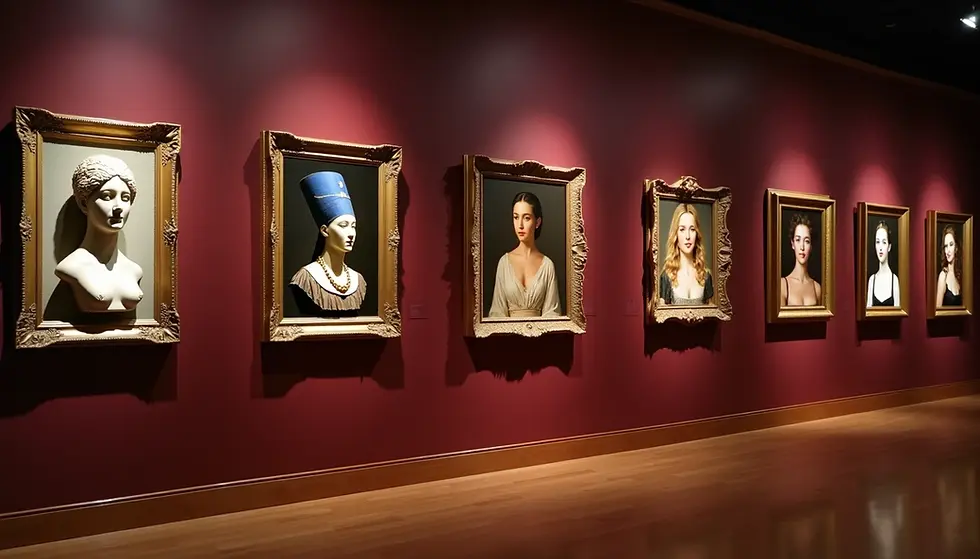Balayage: A French-Inspired Artistic Revolution in Hair Dying
- Margaux Salon

- Oct 20, 2023
- 4 min read
When it comes to hair colouring, one technique has stood the test of time, becoming a favourite amongst stylists and clients alike. This technique, known as Balayage, has a rich history that dates back to the 1970s. Originating from France, it's now become a global phenomenon, maintaining its popularity due to its natural, sun-kissed results and low maintenance requirements. This article will delve into the fascinating history of Balayage, its evolution over the years, and why it continues to reign supreme today.

Table of contents
What is Balayage?
Balayage is a French word that translates to 'sweeping' or 'painting'. In the context of hair colouring, it refers to a technique where hair colour is literally 'swept' or 'painted' onto the hair. Unlike traditional foiling methods where colour is uniformly applied, Balayage allows for a more creative, freehand approach. The result is a soft, multi-dimensional, and ultimately more natural look.
The Dawn of Balayage - The Hair Dye Revolution
The Birth of Balayage in Paris
In the early 1970s, the Carita salon in Paris was the birthplace of Balayage. At a time when frosting caps and solid colours were the industry standard for hair colouring, Balayage emerged as a revolutionary alternative. Parisians, renowned for their elegant fashion sense and style, were the first to embrace this natural-looking technique.
Balayage: A Stroke of Genius
The term 'balayage' itself signifies 'sweep away'. It's a freestyle method of applying colour to achieve a naturally blended and seamless look. Unlike the foil technique, which involves sectioning hair into foils, Balayage involves treating the hair as a whole. This results in a more uniform effect, with a soft blend of light and dark shades artistically placed to enhance the individual's face shape and cut.

The Evolution of Balayage: From Dip Dye to Ombre and Beyond
Over time, Balayage has evolved, adapting and integrating other popular techniques to create new styles and trends.
Dip Dye: The Beginning
Before Balayage, there was Dip Dye. As the name suggests, Dip Dye involved creating a distinct, high-contrast colour line in the hair, almost as if the hair had been 'dipped' in dye. While this technique was a hit in its time, it was far from the natural, blended look that Balayage offers.
The Ombre Effect
From Dip Dye, the hair colouring techniques evolved to what we know as Ombre. Ombre, meaning 'shaded' in French, involves a gradual transition from a darker colour at the roots to a lighter colour at the ends. While Ombre was a step towards the more natural look of Balayage, it generally resulted in a three-tier colour effect – dark, medium, light – each diffusing into the other.
The Natural Fade Ombre
The natural fade Ombre was a further refinement of the classic Ombre. It involved adding different tones through the ends of the hair while keeping the top section darker, creating a softer look compared to the stark three-tier effect of the classic Ombre.
Balayage: The Modern Phenomenon
From the natural fade Ombre, modern Balayage was born. While it still maintains the basic principle of darker roots and lighter ends, Balayage introduced greater variation in tone and a more natural, sun-kissed look. Experts even use different techniques to create modern Balayage looks, depending on the client's hair and desired outcome.

Balayage: Not Just for Blondes
Although often associated with blondes, Balayage is a versatile technique that works for all hair types and colours. Brunettes, redheads, and even those with black hair can get subtle but effective results with Balayage. For instance, a dark brunette could get swirls of cinnamon or caramel for added dimension.
Foils Vs. Balayage: The Great Debate
When comparing Balayage to traditional foiling methods, the difference is clear. Foils often result in uniform, artificial-looking highlights. Balayage, on the other hand, creates natural-looking swipes of colour that flow from thick to thin, playing off the hair's natural movement. Plus, Balayage doesn't leave any demarcation lines, making for a softer and more manageable grow-out.

Foilyage: The Best of Both Worlds
Despite the advantages of Balayage, some stylists have found a way to combine it with the vibrant colour payoff of foil highlights. This technique, known as Foilyage, involves painting the hair as in Balayage but adds foil for enhanced lightening. The result is natural-looking highlights with a bit more 'pop'.
The Continued Popularity of Balayage
So, why has Balayage remained so popular over the years? The answer lies in its versatility and low maintenance. Whether you want subtle highlights, dramatic colour contrasts, or vibrant fashion colours, Balayage can achieve it all. Plus, with its natural look and seamless grow-out, Balayage requires less frequent touch-ups compared to other colouring methods.

Conclusion: The Lasting Legacy of Balayage
From its humble beginnings in a Parisian salon to its current status as a global hair colouring phenomenon, Balayage has truly stood the test of time. Its versatility, natural look, and low maintenance have made it a favourite among both stylists and clients. As we look to the future, it's clear to see that Balayage is more than just a trend – it's a timeless technique that's here to stay.
Whether you're considering Balayage for the first time or are a long-time fan, it's essential to find a skilled stylist experienced in this technique. The artful placement of light and dark shades is key to achieving the best Balayage results. With the right stylist and the right approach, you can achieve a look that's truly unique to you. And that's the true beauty of Balayage.








Comments